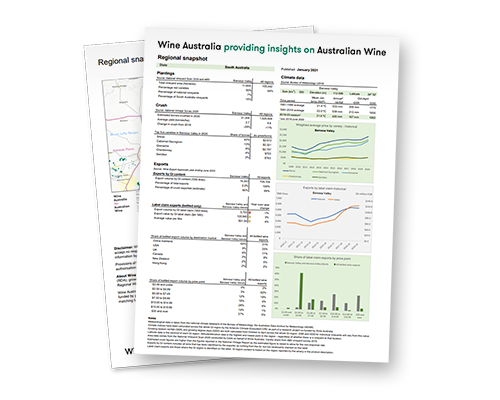Just east of Melbourne, in Victoria, is the wine region of Yarra Valley. It has one of the lowest mean January temperatures of the Victorian wine regions (18.9℃) and is one of the largest wine regions outside of Murray Darling - Swan Hill.
The GI is 3,130 km2 in size and has a total of 2,837 hectares of vineyards. The main varieties grown in the region are Pinot Noir, Chardonnay, Shiraz, and Cabernet Sauvignon.

Yarra Valley Regional Snapshot 2024-25
Regional Snapshots are one-page profiles updated annually of individual Australian wine regions. They provide at-a-glance summary statistics on: climatic characteristics, viticulture data, winegrape production, and winegrape price and export sales data for wine, compared against the same statistics for the whole of Australia.
Download now



Cabernet Sauvignon
Often blended with small proportions of Cabernet Franc and Merlot, the style of Yarra Cabernet ranges from medium to full-bodied with silky tannins, to aromatic and floral with herbal characters.
Chardonnay
Grows successfully in the Yarra Valley’s cool climate. Typical flavours of white peach, melon and fig. Fruit sourced from the coolest sites is also used for top quality sparkling wine production.
Pinot Noir
One of the premier red varieties of the region. Ranging from light to medium-bodied with typical flavours of plum, strawberry and cherry. Some of the fruit from the coolest sites is used for high quality sparkling wine production.
Shiraz
A rising star in the region, site selection is important. Often co-fermented with small percent of Viognier for aroma and texture. Some of the top small-production wineries are now choosing to label the wines Syrah.

- Difference in altitude and aspect leads to substantial variation in mesoclimate
- Even warmest sites are relatively cool
- Mean January temperature in Healesville is 19.4°C
- Of the annual rainfall of 1160mm only 200mm falls between October and April

- Grey-brown sandy loam with a mix of rocky clay sub-soil. Derived from the ancient sandstone of the Great Dividing Range
- Younger red soils of volcanic origin
